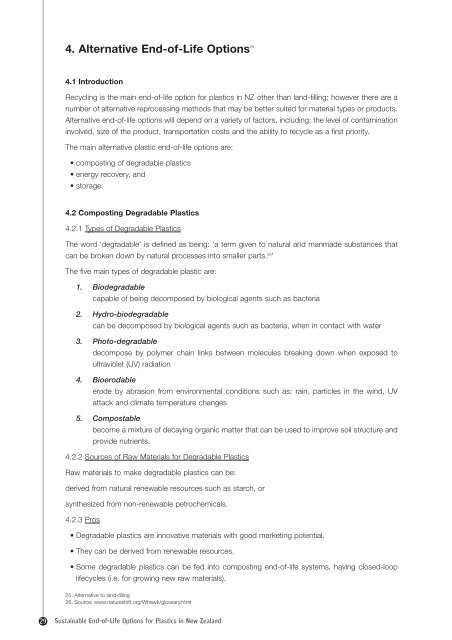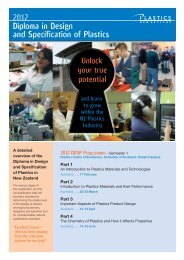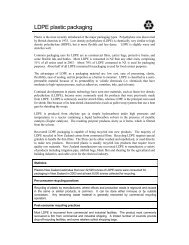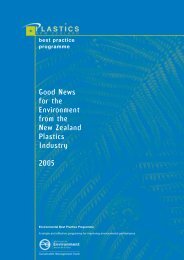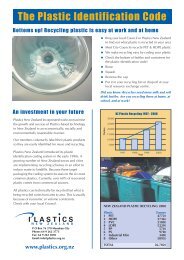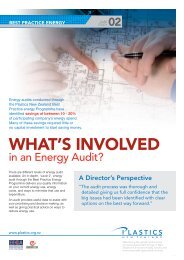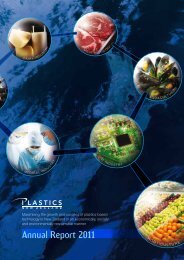Sustainable End-of-Life Options for Plastics in New Zealand
Sustainable End-of-Life Options for Plastics in New Zealand
Sustainable End-of-Life Options for Plastics in New Zealand
You also want an ePaper? Increase the reach of your titles
YUMPU automatically turns print PDFs into web optimized ePapers that Google loves.
4. Alternative <strong>End</strong>-<strong>of</strong>-<strong>Life</strong> <strong>Options</strong> 25<br />
4.1 Introduction<br />
Recycl<strong>in</strong>g is the ma<strong>in</strong> end-<strong>of</strong>-life option <strong>for</strong> plastics <strong>in</strong> NZ other than land-fill<strong>in</strong>g; however there are a<br />
number <strong>of</strong> alternative reprocess<strong>in</strong>g methods that may be better suited <strong>for</strong> material types or products.<br />
Alternative end-<strong>of</strong>-life options will depend on a variety <strong>of</strong> factors, <strong>in</strong>clud<strong>in</strong>g: the level <strong>of</strong> contam<strong>in</strong>ation<br />
<strong>in</strong>volved, size <strong>of</strong> the product, transportation costs and the ability to recycle as a first priority.<br />
The ma<strong>in</strong> alternative plastic end-<strong>of</strong>-life options are:<br />
• compost<strong>in</strong>g <strong>of</strong> degradable plastics<br />
• energy recovery, and<br />
• storage.<br />
4.2 Compost<strong>in</strong>g Degradable <strong>Plastics</strong><br />
4.2.1 Types <strong>of</strong> Degradable <strong>Plastics</strong><br />
The word ‘degradable’ is def<strong>in</strong>ed as be<strong>in</strong>g: ‘a term given to natural and manmade substances that<br />
can be broken down by natural processes <strong>in</strong>to smaller parts. 26 ’<br />
The five ma<strong>in</strong> types <strong>of</strong> degradable plastic are:<br />
1. Biodegradable<br />
capable <strong>of</strong> be<strong>in</strong>g decomposed by biological agents such as bacteria<br />
2. Hydro-biodegradable<br />
can be decomposed by biological agents such as bacteria, when <strong>in</strong> contact with water<br />
3. Photo-degradable<br />
decompose by polymer cha<strong>in</strong> l<strong>in</strong>ks between molecules break<strong>in</strong>g down when exposed to<br />
ultraviolet (UV) radiation<br />
4. Bioerodable<br />
erode by abrasion from environmental conditions such as: ra<strong>in</strong>, particles <strong>in</strong> the w<strong>in</strong>d, UV<br />
attack and climate temperature changes<br />
5. Compostable<br />
become a mixture <strong>of</strong> decay<strong>in</strong>g organic matter that can be used to improve soil structure and<br />
provide nutrients.<br />
4.2.2 Sources <strong>of</strong> Raw Materials <strong>for</strong> Degradable <strong>Plastics</strong><br />
Raw materials to make degradable plastics can be:<br />
derived from natural renewable resources such as starch, or<br />
synthesized from non-renewable petrochemicals.<br />
4.2.3 Pros<br />
• Degradable plastics are <strong>in</strong>novative materials with good market<strong>in</strong>g potential.<br />
• They can be derived from renewable resources.<br />
• Some degradable plastics can be fed <strong>in</strong>to compost<strong>in</strong>g end-<strong>of</strong>-life systems, hav<strong>in</strong>g closed-loop<br />
lifecycles (i.e. <strong>for</strong> grow<strong>in</strong>g new raw materials).<br />
25. Alternative to land-fill<strong>in</strong>g<br />
26. Source: www.natureshift.org/Whawk/glossary.html<br />
29 <strong>Susta<strong>in</strong>able</strong> <strong>End</strong>-<strong>of</strong>-<strong>Life</strong> <strong>Options</strong> <strong>for</strong> <strong>Plastics</strong> <strong>in</strong> <strong>New</strong> <strong>Zealand</strong>


